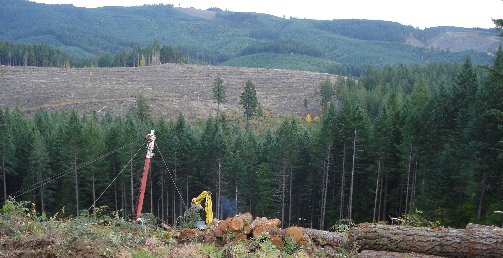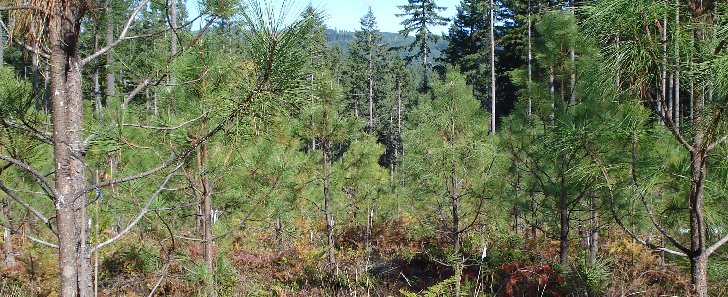The pictures are from Little Beaver Creek Tree Farm in western Oregon. Below are new trees planted in back of “heritage trees” left for cover, wildlife & beauty.

Lobbyists have a bad reputation and there sure are some high profile crooks, but no democray can properly work w/o lobbyists and the bigger the government the more you need lobbyist.
Most people know more about their own business than others know about it. That just makes sense. That doesn’t mean that others do not have strong opinions and many are enthusastic about spending other people’s money and creating regulations that prevent them from using their property. Forestry is a strong example.
About 60% of America’s productive forests are family owned, but most people don’t know that. They think that government or big business runs the show and they are eager to control what they consider a common resource. It is possible to be both ignorant and passionate and this state of affairs describes much of the urban-based environmental movement. (As Yeats wrote nearly ninety years ago, “the best lack all conviction, while the worst are full of passionate intensity. That remains true.)
Below is a forest harvest. You can see the different generations of trees. In the middle are sixty year old trees. Those trees are the result of a clearcut done a generation ago and you can see how the forest has come back strong and in good health. Behind them is a planting of trees around ten years old. The clearcut was done recently and will be replanted next year. Douglas fir has to be managed with clearcut, since the young trees of this species require full light. This kind of forestry was abused in the past and that colors people’s perceptions today. Things have changed, but perceptions have not and the use of clearcut in forestry is misunderstood by the general public. Well managed forests grow faster and are less prey to bugs, blowdowns and fires.

BTW – the guys doing the cutting work for Pihl forestry. They were featured on the History Channel show called “Ax Men.”
Forest owners are more interested in taking care of their forests than following the politics of forestry. Yet very often the biggest risk to their trees and their freedom to make decisions about what is best comes not from bark beetles or ice storms but from Washington or their state capitals. There is a fairly constant assault on our rights usually from well meaning people often led by committed radicals who dislike the very idea of private property.
Take a very simple example – rabbits. Any gardener knows that rabbits are not uncommon or endangered. However, there are some places where they are less common. In the State of Maine, for example, cottontails are in decline as the cut-over lands where they thrived are growing into mature forests. Is this a problem? It could be if the government gets involved. The simple fact is that all animals and plants have a natural range and each natural range has a limit. If you go to Florida you find lots of alligators. In Wisconsin you don’t find any outside the zoo. Someplace between Wisconsin and Florida is the edge of the alligators’ natural habitat. Along that line, alligators are rare. You could say that they are locally endangered. Should the government specifically regulate and protect alligators at this line? Of course not. Natural ranges naturally expand and contract. Everyplace in America lies on the edge of some plant or animal range, so everyplace in America has some locally endangered plants or animals. You can see the potential for unscrupulous individuals to call for more regulation. Throw in some cute pictures and you can get laws passed to stop “timber barons” like me and my friends from harvesting their trees.

Above is a ponderosa pine planation that replaced a fir forest. The douglas fir blew down in a wind storm in 1996. Foresters discovered that the trees had root rot and that it was still there, kind of like mold in your house. Root rot spreads through the living roots of the fir. The only way to get rid of it is to plant species that will not get it. The pines are not immune, but they can resist better than the fir. The fir forest would regenerate naturally and be blown down again and again because of the rot, which would spread. The fir forest would be chronically harmed by the root rot for a long time, maybe for centuries until a forest fir destroyed it. One of the benefits of a well managed forest is to find and fix these kinds of problems.
The pines are a subspecies of the ponderosa pine that specifically grows west of the Cascades. The ponderosa pines that are common on the eastern side or in the rockies do not grow well in the pacific coast regions.
I am glad that my lobbyist keeps track of these sorts of things for me. I have other things to do. I cannot spend the time and I do not have the skills to keep track of all the sneaky attempts control my land.
I am thankful for some lobbyists to protect me from politicians & activists.
